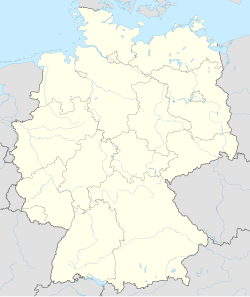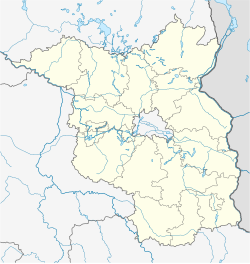world.wikisort.org - Germany
Cottbus (German pronunciation: [ˈkɔtbʊs] (![]() listen)) or Chóśebuz (Lower Sorbian pronunciation: [ˈxɨɕɛbus]) is a university city and the second-largest city in Brandenburg, Germany. Situated around 125 km (78 mi) southeast of Berlin, on the River Spree, Cottbus is also a major railway junction with extensive sidings/depots. Although only a small Sorbian minority lives in Cottbus itself, the city is considered as the political and cultural center of the Sorbs in Lower Lusatia.
listen)) or Chóśebuz (Lower Sorbian pronunciation: [ˈxɨɕɛbus]) is a university city and the second-largest city in Brandenburg, Germany. Situated around 125 km (78 mi) southeast of Berlin, on the River Spree, Cottbus is also a major railway junction with extensive sidings/depots. Although only a small Sorbian minority lives in Cottbus itself, the city is considered as the political and cultural center of the Sorbs in Lower Lusatia.
Cottbus
Chóśebuz | |
|---|---|
Town | |
|
From top: View of Cottbus at sunset, The Art-Nouveau façade of the State Theater (1905), The 14th cent. Spremberger Tower, View on the Karl-Liebknecht Str, The library of the Brandenburg University of Technology | |
 Flag  Coat of arms | |
Location of Cottbus  | |
 Cottbus  Cottbus | |
| Coordinates: 51°45′38″N 14°20′03″E | |
| Country | Germany |
| State | Brandenburg |
| District | Urban district |
| Government | |
| • Lord mayor (2014–22) | Holger Kelch[1] (CDU) |
| Area | |
| • Total | 164.28 km2 (63.43 sq mi) |
| Elevation | 70 m (230 ft) |
| Population (2020-12-31)[2] | |
| • Total | 98,693 |
| • Density | 600/km2 (1,600/sq mi) |
| Time zone | UTC+01:00 (CET) |
| • Summer (DST) | UTC+02:00 (CEST) |
| Postal codes | 03042-03055 |
| Dialling codes | 0355 |
| Vehicle registration | CB |
| Website | www.cottbus.de |
Spelling
Until the beginning of the 20th century, the spelling of the city's name was disputed. In Berlin, the spelling "Kottbus" was preferred, and it is still used for the capital's Kottbusser Tor ("Cottbus Gate"), but locally the traditional spelling "Cottbus" (which defies standard German-language rules) was preferred, and it is now used in most circumstances. Because the official spelling used locally before the spelling reforms of 1996 had contravened even the standardized spelling rules already in place, the Standing Committee for Geographical Names (German: Ständiger Ausschuss für geographische Namen) stress their urgent recommendation that geographical names should respect the national spelling standards. A citizen of the city may be identified as either a "Cottbuser" or a "Cottbusser".
Names in different languages:
- Czech: Chotěbuz
- German: Cottbus
- Latin: Cotbusium
- Polish: Chociebuż
- Lower Sorbian: Chóśebuz
- Upper Sorbian: Choćebuz
- Yiddish: קוטבוס, romanized: Kotbus
History
March of Lusatia 965–1002
Duchy of Poland 1002–1025
Kingdom of Poland 1025–1031
Duchy of Poland 1032
March of Lusatia 1032–1367
Bohemian Crown 1367–1445
Margraviate of Brandenburg 1445–1618
Brandenburg-Prussia 1618–1701
Kingdom of Prussia 1701–1807
Kingdom of Saxony 1807–1815
Kingdom of Prussia 1815–1871
German Empire 1871–1918
Weimar Republic 1918–1933
Nazi Germany 1933–1945
Allied-occupied Germany 1945–1949
German Democratic Republic 1949–1990
Federal Republic of Germany 1990–present
The settlement was established in the tenth century, when Sorbs erected a castle on a sandy island in the River Spree. The first recorded mention of the town's name was in 1156. In the 13th century German settlers came to the town and thereafter lived side by side with the Sorbs.
In the Middle Ages Cottbus was known for wool, and the town's drapery was exported throughout Brandenburg, Bohemia and Saxony. It was part of the Margraviate of Lusatia and later Lower Lusatia, which was held by the House of Wettin until it became a Bohemian Crown Land in 1367.
In 1445 Cottbus was acquired by the Margraviate of Brandenburg from Bohemia. It was an exclave almost completely surrounded by Bohemian Lower Lusatia (with a short border with the Electorate of Saxony to the south-west). In 1514 Jan Rak founded the Universitas Serborum, a Sorbian gymnasium, in the city. In 1635 Lower Lusatia was ceded by Bohemia to Saxony, thereby making Cottbus an enclave of Saxony. In 1701 Brandenburg-Prussia became the Kingdom of Prussia.
In 1807, following the War of the Fourth Coalition, Cottbus was ceded by Prussia to the Kingdom of Saxony by the Treaty of Tilsit, reuniting it with Lower Lusatia. Cottbus was returned to Prussia by the Congress of Vienna in 1815 after the Napoleonic wars. Lower Lusatia was also ceded to Prussia and both became part of the Prussian Province of Brandenburg (and Regierungsbezirk Frankfurt), where they remained until 1947.
In 1871 Prussia, and therefore Cottbus, became part of the German Empire. According to the Prussian census of 1905, the city of Cottbus had a population of 46,270, of which 97% were Germans, 2% were Sorbs and 1% were Poles.[3]
In interwar Germany, the town was the site of a concentration camp for unwanted Jewish immigrants from Eastern Europe.[4]
During World War II, a Nazi prison for women was operated in the city with multiple forced labour subcamps located both in the city and other places in the region.[5] In the final weeks of the war, Cottbus was taken by the Red Army on 22 April 1945. In January 1946, Cottbus issued 34 semi-postal postage stamps to help finance rebuilding the city. From 1949 until German reunification in 1990, Cottbus was part of the German Democratic Republic (East Germany). From 1952 to 1990, Cottbus was the administrative seat of Bezirk Cottbus.
Demography
 Development of population since 1875 within the current Boundaries (Blue Line: Population; Dotted Line: Comparison to Population development in Brandenburg state; Grey Background: Time of Nazi Germany; Red Background: Time of communist East Germany)
Development of population since 1875 within the current Boundaries (Blue Line: Population; Dotted Line: Comparison to Population development in Brandenburg state; Grey Background: Time of Nazi Germany; Red Background: Time of communist East Germany) Recent Population Development and Projections (Population Development before Census 2011 (blue line); Recent Population Development according to the Census in Germany in 2011 (blue bordered line); Official projections for 2005-2030 (yellow line); for 2017-2030 (scarlet line); for 2020-2030 (green line)
Recent Population Development and Projections (Population Development before Census 2011 (blue line); Recent Population Development according to the Census in Germany in 2011 (blue bordered line); Official projections for 2005-2030 (yellow line); for 2017-2030 (scarlet line); for 2020-2030 (green line)
|
|
|
Culture and education


Cottbus is the cultural centre of the Lower Sorbian minority. Many signs in the town are bilingual, and there is a Lower Sorbian-medium Gymnasium and a Sorbian Quarter, but Sorbian is rarely spoken on the streets.
Next to Cottbus is the famous Branitz Park, created by Prince Hermann von Pückler-Muskau after 1845. Schloss Branitz (Branitz Castle) was rebuilt by Gottfried Semper in a late Baroque style between 1846 and 1852, and the gardens Prince Hermann laid feature two pyramids. One of these, the Seepyramide, is in the middle of an artificial lake and serves as his mausoleum.[7]
Cottbus is also home to the Brandenburg University of Technology (BTU) and the maths/science-oriented Max-Steenbeck-Gymnasium, named after the physicist Max Steenbeck.
Every year Cottbus hosts the East Europe International Film Festival.
Cottbus has a soccer team, Energie Cottbus, that plays in the Regionalliga Nordost as of the 2021–2022 season. Their home matches are played at the city's Stadion der Freundschaft.
Economy
Transportation

Cottbus is served by Cottbus Hauptbahnhof main railway station.
Two airports serve the city: Cottbus-Drewitz Airport (approximately 25 kilometres (16 mi) north-east of Cottbus), and Cottbus-Neuhausen Airport (approximately 10 km (6.2 miles) south-east of Cottbus).
Local public transport is served by trams and buses operated by Cottbusverkehr GmbH and DB Regio Bus Ost GmbH, both of which are members of the Verkehrsverbund Berlin-Brandenburg (VBB).
Power generation
There are several lignite-fired power stations in the area around Cottbus (Lausitz) fed through local open pit mining. The biggest stations are "Schwarze Pumpe" (1600 MW), "Boxberg" (1900 MW) and "Jänschwalde" (3000 MW). Some of the open-pit mines have already been shut down with the former Cottbus-Nord opencast mine being converted into an artificial lake with 19 km2 (7.3 sq mi) surface area called Cottbuser Ostsee (Cottbus eastern lake).
Twin towns – sister cities
Cottbus is twinned with:[8]
 Montreuil, France (1959)
Montreuil, France (1959) Grosseto, Italy (1967)
Grosseto, Italy (1967) Lipetsk, Russia (1974)
Lipetsk, Russia (1974) Zielona Góra, Poland (1975)
Zielona Góra, Poland (1975) Targovishte, Bulgaria (1975)
Targovishte, Bulgaria (1975) Košice, Slovakia (1978)
Košice, Slovakia (1978) Saarbrücken, Germany (1987)
Saarbrücken, Germany (1987) Gelsenkirchen, Germany (1995)
Gelsenkirchen, Germany (1995) Nuneaton and Bedworth, England, United Kingdom (1999)
Nuneaton and Bedworth, England, United Kingdom (1999)
Notable people

- Janice Behrendt (born 1983), beauty queen and model
- Carl Blechen (1798–1840), landscape painter
- Kurt Demmler (1943–2009), songwriter; accused of sexual abuse, he hanged himself in his jail cell.
- Rudi Fink (born 1958), amateur boxer and boxing coach
- Gustav Theodor Fritsch (1838–1927), anatomist, anthropologist and physiologist
- Marco Geisler (born 1974), rower
- Robert Harting (born 1984), discus thrower
- Otto Hugo Paul Grottkau (1846–1898), socialist and trade unionist and American journalist
- Tony Martin (born 1985), cyclist
- Jens Melzig (born 1965), footballer
- Daniel Musiol (born 1983), cyclist
- Reinhold Platz (1886–1966), aircraft designer and manufacturer at Fokker
- Gabriele Reinsch (born 1963), world record holder discus throwing
- Viktoria Schmidt-Linsenhoff (1944–2013), art historian and professor
- Heiko Schwarz (born 1989), footballer
See also
References
- Ergebnis der Oberbürgermeisterwahl in Cottbus, accessed 30 June 2021.
- "Bevölkerung im Land Brandenburg nach amtsfreien Gemeinden, Ämtern und Gemeinden 31. Dezember 2020". Amt für Statistik Berlin-Brandenburg (in German). June 2021.
- Belzyt, Leszek (1998). Sprachliche Minderheiten im preussischen Staat: 1815 - 1914 ; die preußische Sprachenstatistik in Bearbeitung und Kommentar. Marburg: Herder-Inst. ISBN 978-3-87969-267-5.
- Stone, Dan (2017). Concentration Camps: A Very Short Introduction. Oxford University Press. p. 31. ISBN 978-0-19-103502-9.
- "Frauenzuchthaus Cottbus". Bundesarchiv.de (in German). Retrieved 30 October 2021.
- Detailed data sources are to be found in the Wikimedia Commons.Population Projection Brandenburg at Wikimedia Commons
- Udo Lauer, Fürst Pücklers Traumpark, Ullstein Verlag, 1996, Berlin
- "Städtepartnerschaften". cottbus.de (in German). Cottbus. Retrieved 11 February 2021.
External links
 Cottbus travel guide from Wikivoyage
Cottbus travel guide from Wikivoyage- Official website (in German, English, Polish, and Lower Sorbian)
- Homepage of Brandenburg Technical University
- . Encyclopædia Britannica (11th ed.). 1911.
На других языках
[de] Cottbus
Cottbus, niedersorbisch Chóśebuz [.mw-parser-output .IPA a{text-decoration:none}ˈxɨɕɛbus], ist eine kreisfreie Universitätsstadt mit 98.359 Einwohnern (31. Dezember 2021) im Land Brandenburg. Nach dessen Hauptstadt Potsdam ist sie hinsichtlich der Bevölkerungszahl die zweitgrößte Stadt und, neben Brandenburg an der Havel und Frankfurt (Oder), eines der vier Oberzentren des Landes. Cottbus gilt als politisch-kulturelles Zentrum der Sorben in der Niederlausitz, obwohl in der Stadt nur eine kleine Minderheit wohnt. Die Mittelstadt ist ein Dienstleistungs-, Sport-, Wissenschafts- und Verwaltungszentrum. Hier befinden sich ein Olympiastützpunkt, das Staatstheater Cottbus sowie der Campus Cottbus der Brandenburgischen Technischen Universität.- [en] Cottbus
[ru] Котбус
Ко́тбус (нем. Cottbus [ˈkɔtbʊs], н.-луж. Chóśebuz [ˈχɛɕɛbus]/[ˈχɨɕɛbus], в.-луж. Choćebuz, [ˈkʰɔt͡ʃɛbus]) — город на востоке Германии, на реке Шпре; второй по величине город земли Бранденбург (после Потсдама), где имеет статус внерайонного города.Другой контент может иметь иную лицензию. Перед использованием материалов сайта WikiSort.org внимательно изучите правила лицензирования конкретных элементов наполнения сайта.
WikiSort.org - проект по пересортировке и дополнению контента Википедии






